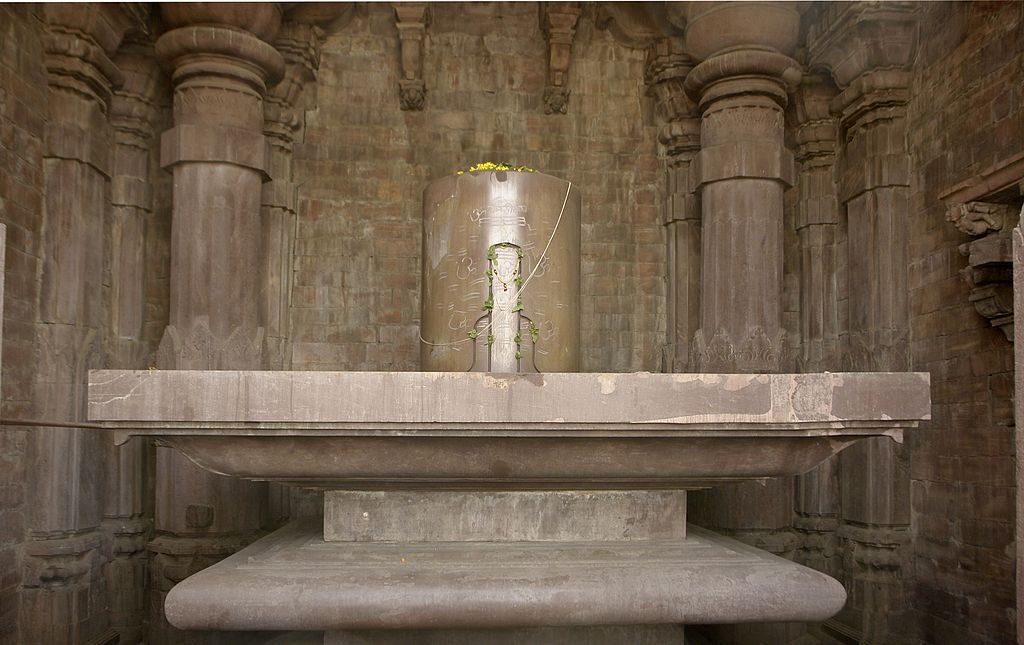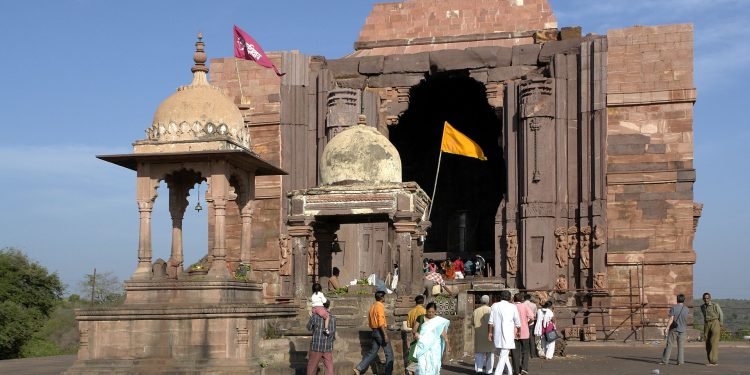The Bhojeshwar Temple is an incomplete Hindu temple in Bhojpur village of Madhya Pradesh, India. Dedicated to Shiva, it houses a 7.5 feet high lingam in its sanctum.
Shrine’s History
The Bhojpur temple is believed to have been constructed by the 11th-century Paramara king Bhoja. Tradition also attributes to him the establishment of Bhojpur and the construction of now-breached dams in the area. Because the temple was never completed, it lacks a dedicatory inscription. However, the name of the area corroborates its association with Bhoja. This belief is further supported by the site’s sculptures, which can be dated to the 11th century with certainty. A Jain temple in Bhojpur, which shares the same sets of mason’s marks with the Shiva temple, has an inscription explicitly dated to 1035 CE.
Besides several literary works, historical evidence confirms that Bhoja’s reign included the year 1035 CE: the Modasa copper plates were issued by Bhoja, and the Chintamani-Sarnika was composed by his court poet Dasabala. Moreover, the area around the temple once featured three dams and a reservoir. The construction of such a large Shiva temple, dams and reservoir could have only been undertaken by a powerful ruler. All this evidence appears to confirm the traditional belief that the temple was commissioned by Bhoja. Archaeology professor Kirit Mankodi dates the temple to the later part of Bhoja’s reign, around mid-11th century. The Udaipur Prashasti inscription of the later Paramara rulers states that Bhoja “covered the earth with temples” dedicated to the various aspects of Shiva, including Kedareshvara, Rameshwara, Somanatha, Kala, and Rudra. Tradition also attributes the construction of a Saraswati temple to him .
The Jain writer Merutunga, in his Prabandha-Chintamani, states that Bhoja constructed 104 temples in his capital city of Dhara alone. However, the Bhojpur temple is the only surviving shrine that can be attributed to Bhoja with some certainty. According to a legend in Merutunga’s Prabandha-Chintamani, when Bhoja visited Srimala, he told the poet Magha about the “Bhojasvāmin” temple that he was about to build, and then left for Malwa . However, Magha was not a contemporary of Bhoja, and therefore, the legend is anachronistic. The temple originally stood on the banks of a reservoir 18.5 long and 7.5 miles wide. This reservoir was formed through the construction of 3 earth-and-stone dams during Bhoja’s reign.
The first dam, built on Betwa River, trapped the river waters in a depression surrounded by hills. A second dam was constructed in a gap between the hills, near present-day Mendua village. A third dam, located in present-day Bhopal, diverted more water from the smaller Kaliasot river into the Betwa dam reservoir. This man-made reservoir existed until the 15th century when Hoshang Shah emptied the lake by breaching two of the dams.


Architectural Relevance of This Shrine
The temple lies on a platform 115 feet long, 82 feet wide and 13 feet high. On the platform lies a sanctum containing a large lingam. The sanctum plan comprises a square; on the outside, each side measures 65 feet ; on the inside, each measures 42.5 feet . The lingam is built using three superimposed limestone blocks. The lingam is 7.5 feet high and 17.8 feet in circumference. It is set on a square platform, whose sides measure 21.5 feet. The total height of the lingam, including the platform, is over 40 feet . The doorway to the sanctum is 33 feet high. The wall at the entrance features sculptures of apsaras, ganas and river goddesses. The temple walls are window-less and are made of large sandstone blocks.
The pre-restoration walls did not have any cementing material. The northern, southern and eastern walls feature three balconies, which rest on massive brackets. These are faux balconies that are purely ornamental. They are not approachable from either inside or outside of the temple, because they are located high up on the walls, and have no openings on the interior walls. The northern wall features a makara-shaped spout, which provided a drainage outlet for the liquid used to bathe the lingam. Other than the sculptures on the front wall, this makara sculpture is the only carving on the external walls. images of goddesses were originally placed high up on the four interior walls ; only one of these images now remains. The four brackets supporting the cornerstones feature four different divine couples: Shiva-Parvati, Brahma-Shakti, Rama-Sita, and Vishnu-Lakshmi. A single couple appears on all the three faces of each bracket.
While the superstructure remains incomplete, it is clear that the shikhara was not intended to be curvilinear. According to Kirit Mankodi, the shikhara was intended to be a low pyramid-shaped samvarana roof, usually featured in the mandapas. According to Adam Hardy, the shikhara probably intended to be of phamsana style, although it is of bhumija style in its detailing. The incomplete but richly carved dome is supported by four octagonal pillars, each 39.96 feet high. Each pillar is aligned with 3 pilasters. These 4 pillars and 12 pilasters are similar to the navaranga-mandapas of some other medieval temples, in which 16 pillars were organised to make up 9 compartments. The remnants of a sloping ramp can be seen on the north-eastern corner of the building. The ramp is built of sandstone slabs, each measuring 39 x 20 x 16 inches. The slabs are covered with soil and sand. The ramp itself is 300 feet long and slopes upwards to a height of 40 feet . Originally, the ramp reached up to the temple wall, but currently, a gap exists between the two.

Shrine’s Map Location and How to Go There
By Road
Bhojpur has good connectivity with Bhopal via road. Bhopal being the railroad and highway transportation hub, it has a very effective inter state road transport facilities. After reaching Bhopal, the travellers can avail the metro or radio taxi services available in plenty. The interstate bus terminal in Bhopal is near the Habibganj station.
By Rail
Closest Railway station to Bhojpur is Bhopal Junction Railway Station. It is on the main north-south line and is well connected by rail to almost all parts of the country. The station belongs to the West Central Railway Zone
By Air
The closest airport being at Bhopal is at 28 km distance.
Shrine Timings
06:00 to 20:00 All days of the week
Events Celebrated at This Shrine
Maha Shivaratri













































